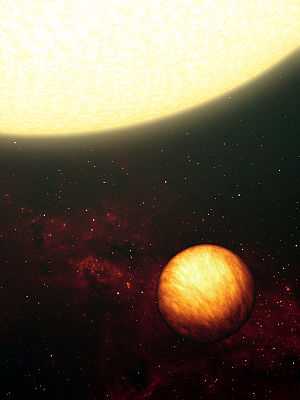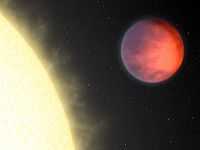Upsilon Andromedae b
| Extrasolar planet | List of extrasolar planets | |
|---|---|---|
 | ||
| Parent star | ||
| Star | Upsilon Andromedae A | |
| Constellation | Andromeda | |
| Right ascension | (α) | 01h 36m 47.8s |
| Declination | (δ) | +41° 24′ 20″ |
| Apparent magnitude | (mV) | 4.09 |
| Distance | 44.0 ± 0.1 ly (13.49 ± 0.03 pc) | |
| Spectral type | F8V | |
| Mass | (m) | 1.28 M☉ |
| Radius | (r) | 1.480 ± 0.087 R☉ |
| Temperature | (T) | 6074 ± 13.1 K |
| Metallicity | [Fe/H] | 0 |
| Age | 3.3 Gyr | |
| Orbital elements | ||
| Semimajor axis | (a) | 0.0595 ± 0.0034 AU (~8.91 Gm) |
| ~4.41 mas | ||
| Periastron | (q) | 0.0549 ± 0.0046 AU (~8.22 Gm) |
| Apastron | (Q) | 0.0609 ± 0.0046 AU (~9.11 Gm) |
| Eccentricity | (e) | 0.022±0.007[1] |
| Orbital period | (P) | 4.62±0.23[1] d (0.01328 y) |
| (~116.4 h) | ||
| Inclination | (i) | ~25[2]° |
| Argument of periastron |
(ω) | 63.4° |
| Time of periastron | (T0) | 2,451,802.64 ± 0.71 JD |
| Semi-amplitude | (K) | 69.8 ± 1.5 m/s |
| Physical characteristics | ||
| Minimum mass | (m sin i) | 0.62 ± 0.09[1] MJ |
| Discovery information | ||
| Discovery date | June 23, 1996 | |
| Discoverer(s) | Marcy et al. | |
| Discovery method | Radial velocity | |
| Other detection methods | Reflection/emission modulations | |
| Discovery site | California and Carnegie Planet Search | |
| Discovery status | Published | |
| Other designations | ||
| Database references | ||
| Extrasolar Planets Encyclopaedia | data | |
| SIMBAD | data | |
| Exoplanet Archive | data | |
| Open Exoplanet Catalogue | data | |
Upsilon Andromedae b, occasionally referred to as Upsilon Andromedae Ab (to distinguish it from the red dwarf Upsilon Andromedae B), is an extrasolar planet approximately 44 light-years away from Earth in the constellation of Andromeda (the Chained Maiden). The planet was discovered orbiting the Solar twin star, Upsilon Andromedae, approximately every five days. Discovered in June 1996 by Geoffrey Marcy and R. Paul Butler, it was one of the first hot Jupiters to be discovered. It is also one of the first non-resolved planets to be detected directly. Upsilon Andromedae b is the innermost known planet in its planetary system.
Discovery
Like the majority of known extrasolar planets, Upsilon Andromedae b was detected by the variations in its star's radial velocity caused by the planet's gravity. The variations were detected by making sensitive measurements of the Doppler shift of Upsilon Andromedae's spectrum. The planet was announced in January 1997, together with 55 Cancri b and the planet orbiting Tau Boötis.[3]
Like 51 Pegasi b, the first extrasolar planet discovered around a normal star, Upsilon Andromedae b orbits very close to its star, closer than Mercury does to our Sun. The planet takes 4.617 days to complete an orbit, with a semimajor axis of 0.0595 AU.[4]
A limitation of the radial velocity method used to detect Upsilon Andromedae b is that only a lower limit on the mass can be found. In the case of Upsilon Andromedae b, this lower limit is 68.7% of the mass of Jupiter, though depending on the inclination of the orbit, the true mass may be much greater. However, astronomers found recently that inclination of the orbital plane is around 25° and the true mass may be about 1.4 MJ.[2] Coplanarity is not to be assumed; the mutual inclination between c and d is 35 degrees.[5]
Physical characteristics
Given the planet's high mass, it is likely that Upsilon Andromedae b is a gas giant with no solid surface.
The Spitzer Space Telescope measured the planet temperature, and found that the difference between the two sides of Upsilon Andromedae b of about 1,400 degrees Celsius, ranging from minus 20 to 230 degrees to about 1,400 to 1,650 degrees Celsius.[6] The temperature difference has led to speculation that Upsilon Andromedae b is tidal locked with the same side always facing Upsilon Andromedae A.
Sudarsky had, on the assumption that the planet is similar to Jupiter in composition and that its environment is close to chemical equilibrium, predicted Upsilon Andromedae b to have reflective clouds of silicates and iron in its upper atmosphere.[7] The cloud deck instead absorbs the sun's radiation; between that and the hot, high pressure gas surrounding the mantle, exists a stratosphere of cooler gas.[8] The outer shell of dark, opaque, hot cloud is assumed to consist of vanadium and titanium oxides ("pM planets"), but other compounds like tholins cannot be ruled out yet.
The planet is unlikely to have large moons, since tidal forces would either eject them from orbit or destroy them on short timescales compared to the age of the system.[9]
The planet (with 51 Pegasi b) was deemed a candidate for direct imaging by Planetpol.[10] Preliminary results from polarimetric studies indicate that the planet has predominately blue color, is 1.36 times as large and 0.74 times as massive as Jupiter, meaning that the mean density is 0.36g/cm3. It has a geometric albedo of 0.35 in visible light.[11]
Effect on its sun

Upsilon Andromedae b appears to be responsible for increased chromospheric activity on its parent star. Observations suggest that there is a "hot spot" on the star around 169° away from the sub-planetary point. This may be the result of interactions between the magnetic fields of the planet and the star. The mechanism may be similar to that responsible for the activity of RS Canum Venaticorum variable stars, or the interaction between Jupiter and its moon Io.[12]
See also
References
- ↑ 1.0 1.1 1.2 Ligi, R. et al. (2012). "A new interferometric study of four exoplanet host stars : θ Cygni, 14 Andromedae, υ Andromedae and 42 Draconis". Astronomy & Astrophysics 545: A5. arXiv:1208.3895. Bibcode:2012A&A...545A...5L. doi:10.1051/0004-6361/201219467.
- ↑ 2.0 2.1 McArthur, Barbara E. et al. (2010). "New Observational Constraints on the υ Andromedae System with Data from the Hubble Space Telescope and Hobby Eberly Telescope" (PDF). The Astrophysical Journal 715 (2): 1203. Bibcode:2010ApJ...715.1203M. doi:10.1088/0004-637X/715/2/1203.
- ↑ Butler, R. Paul et al. (1997). "Three New 51 Pegasi-Type Planets". The Astrophysical Journal 474 (2): L115–L118. Bibcode:1997ApJ...474L.115B. doi:10.1086/310444.
- ↑ Butler, R. P. et al. (2006). "Catalog of Nearby Exoplanets". The Astrophysical Journal 646 (1): 505–522. arXiv:astro-ph/0607493. Bibcode:2006ApJ...646..505B. doi:10.1086/504701. (web version)
- ↑ McArthur, B.; Benedict, G. F.; Bean, J. & Martioli, E. (2007). "Planet Masses in the Upsilon Andromadae system determined with the HST Fine Guidance Sensors". American Astronomical Society Meeting Abstracts 211.
- ↑ Harrington, J; Hansen BM; Luszcz SH; Seager S; Deming D; Menou K; Cho JY; Richardson LJ (October 27, 2006). "The phase-dependent infrared brightness of the extrasolar planet upsilon Andromedae b". Science 314 (5799): 623–6. arXiv:astro-ph/0610491. Bibcode:2006Sci...314..623H. doi:10.1126/science.1133904. PMID 17038587.
- ↑ Sudarsky, David et al. (2003). "Theoretical Spectra and Atmospheres of Extrasolar Giant Planets". The Astrophysical Journal 588 (2): 1121–1148. arXiv:astro-ph/0210216. Bibcode:2003ApJ...588.1121S. doi:10.1086/374331.
- ↑ Ivan Hubeny; Adam Burrows (2008). "Spectrum and atmosphere models of irradiated transiting extrasolar giant planets". Proceedings of the International Astronomical Union 4: 239. arXiv:0807.3588v1. Bibcode:2009IAUS..253..239H. doi:10.1017/S1743921308026458.
- ↑ Barnes, J.; O'Brien, D. (2002). "Stability of Satellites around Close-in Extrasolar Giant Planets". The Astrophysical Journal 575 (2): 1087–1093. arXiv:astro-ph/0205035. Bibcode:2002ApJ...575.1087B. doi:10.1086/341477.
- ↑ Lucas, P. W.; Hough, J. H.; Bailey, J. A.; Tamura, M.; Hirst, E.; Harrison, D. (2007). "Planetpol polarimetry of the exoplanet systems 55 Cnc and tau Boo". arXiv:0807.2568v1 [astro-ph].
- ↑ Andromedae b in polarized light: New constraints on the planet size, density and albedo: S.V. Berdyugina, A.V. Berdyugin, V. Piirola, 14 September 2011
- ↑ Shkolnik, E. et al. (2005). "Hot Jupiters and Hot Spots: The Short- and Long-term Chromospheric Activity on Stars with Giant Planets". The Astrophysical Journal 622 (2): 1075–1090. arXiv:astro-ph/0411655. Bibcode:2005ApJ...622.1075S. doi:10.1086/428037.
External links
- "A Triple-Planet System Orbiting Ups Andromedae". San Francisco State University. Lick Observatory. Retrieved 2008-06-23.
- "Mystery Solved: How The Orbits Of Extrasolar Planets Became So Eccentric". SpaceDaily. 2005-04-14. Retrieved 2008-06-23.
- "NASA's Spitzer Sees Day and Night on Exotic World". NASA. Spitzer Space Telescope. 2006-10-12. Archived from the original on October 22, 2007. Retrieved 2008-06-23.
- "Upsilon Andromedae". The Internet Encyclopedia of Science. Retrieved 2008-06-23.
- "Upsilon Andromedae". The Planet Project. Retrieved 2008-06-23.
- "Upsilon Andromedae 2". SolStation. Retrieved 2008-06-23.
- "The Upsilon Andromedae Planetary System". Harvard-Smithsonian Center for Astrophysics. Retrieved 2008-06-23.
| ||||||||||||||||||
Coordinates: ![]() 01h 36m 47.8s, +41° 24′ 20″
01h 36m 47.8s, +41° 24′ 20″
| ||||||||||||||||||||||||||||||||||||||||||||||||||||||||||||||||||||||